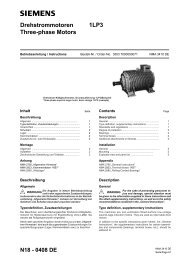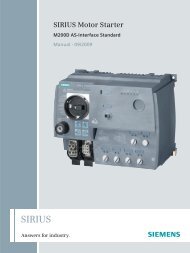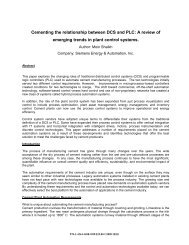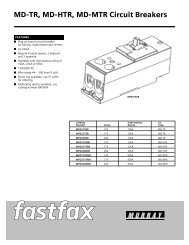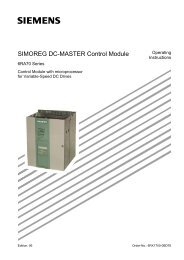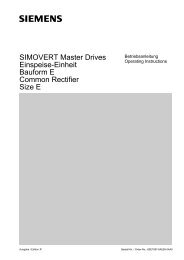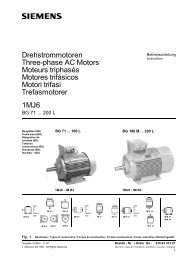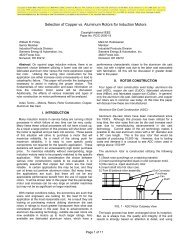WL Circuit Breakers - Siemens
WL Circuit Breakers - Siemens
WL Circuit Breakers - Siemens
You also want an ePaper? Increase the reach of your titles
YUMPU automatically turns print PDFs into web optimized ePapers that Google loves.
External CubicleBUS Modules<br />
<strong>WL</strong> <strong>Circuit</strong> Breaker<br />
ZSI Module<br />
To use the ZSI function with the <strong>WL</strong> <strong>Circuit</strong><br />
Breaker, the external CubicleBUS ZSI module<br />
must be implemented.<br />
The zone selective interlocking (ZSI)<br />
module provides the complete range of<br />
selectivity with the short delay time of<br />
t ZSI = 50 ms, irrespective of the number of<br />
levels and the location of the short-circuit<br />
in the distribution system. Its benefits<br />
become even more apparent, the higher<br />
the number of levels in large systems and<br />
the longer the resulting delay times. By<br />
shortening the time, the ZSI module<br />
significantly reduces stress and damage<br />
in the event of a short-circuit in the<br />
switchgear.<br />
Operating Principle<br />
If the ZSI module is used in a distribution<br />
system comprising several levels, each<br />
circuit breaker affected by a short-circuit<br />
interrogates the circuit breaker directly<br />
downstream, to ascertain whether the<br />
Graphic<br />
2-7<br />
<strong>WL</strong> PROFIBUS/MODBUS Communication and Electronic Accessories<br />
short-circuit also occurred in the next level<br />
below:<br />
• If the short-circuit did occur in the<br />
downstream level, the upstream circuit<br />
breaker delays tripping to ensure that the<br />
circuit breaker directly upstream of the<br />
short-circuit has enough time to<br />
interrupt the short-circuit.<br />
• If the circuit breakers in the downstream<br />
level do not report a short-circuit, the<br />
short-circuit occurred between the two<br />
levels in question. In this case, one<br />
of the two upstream circuit breakers<br />
interrupts the short-circuit once the<br />
programmed delay time of t ZSI = 50 ms<br />
has elapsed.<br />
Example as Illustrated in<br />
Graphic 2-7<br />
This shows a section of a power distribution<br />
system that has been installed with the<br />
ZSI module. <strong>WL</strong> <strong>Circuit</strong> <strong>Breakers</strong> are<br />
implemented at different levels.<br />
Short-circuit at 3:<br />
<strong>Circuit</strong> breakers -Q5, -Q3, and -Q1 establish<br />
that a short-circuit has occurred. -Q5 blocks<br />
-Q3 by means of the ZSI signal and, as a<br />
result, -Q1 too, so that they do not trip in<br />
50 ms. Since -Q5 does not receive a<br />
blocking signal from a subordinate circuit<br />
breaker, it is responsible for interrupting the<br />
short-circuit as quickly as possible. If this<br />
does not take place, because the circuit<br />
breaker is no longer operational due to an<br />
overcurrent, -Q3, as a backup, trips after<br />
the time-discriminating response time of<br />
150 ms.<br />
Short-circuit at 2:<br />
-Q1 and -Q3 establish that a short-circuit<br />
has occurred; -Q5 does not. For this reason,<br />
-Q3 does not receive a blocking signal from<br />
-Q5, but provides a blocking signal for<br />
-Q1. This information tells -Q3 that<br />
it is closest to the short-circuit and trips<br />
with a delay of tS = 50 ms instead of<br />
tsd = 150 ms. Time saved = 100 ms.<br />
This graphic illustrates the operating principle of the ZSI function using an example in a power distribution system. It is also a connection diagram<br />
that shows how the ZSI module must be wired if the <strong>WL</strong> <strong>Circuit</strong> <strong>Breakers</strong> are used.<br />
SECTION 2<br />
2/30




